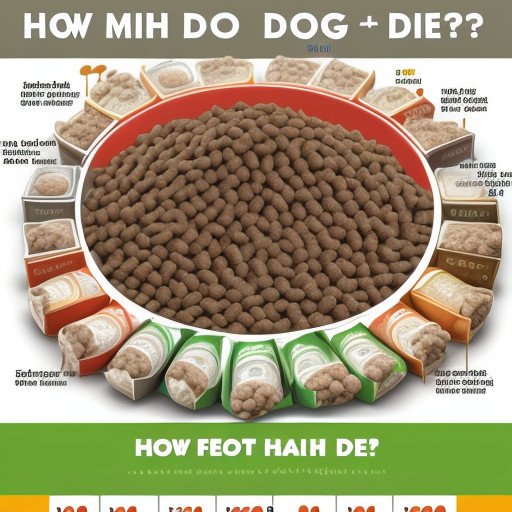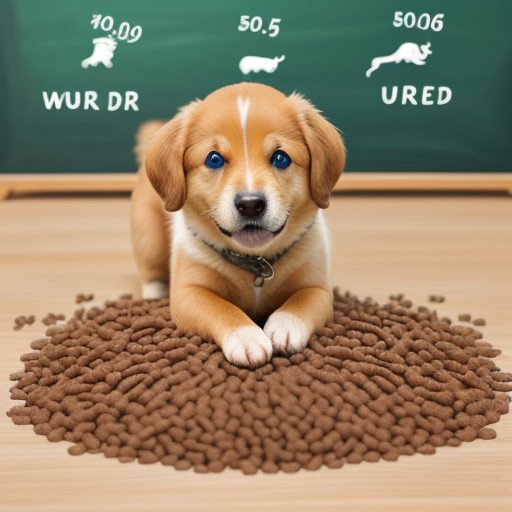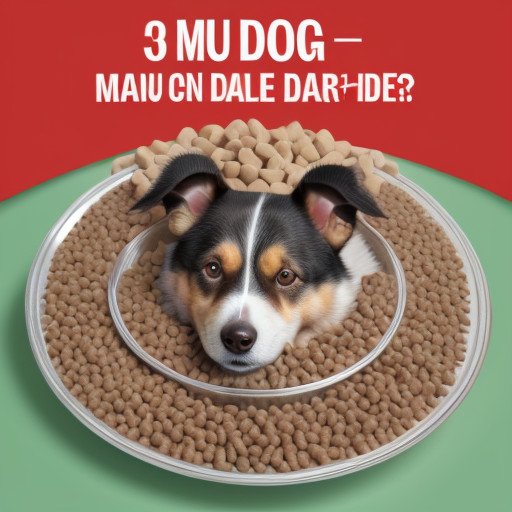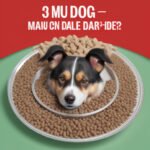” Tailoring the Bowl: Deciphering Your Dog’s Daily Dining Requirements”
Introduction to Feeding Dogs :
Welcoming a furry friend into your home is a joyous occasion, but with it comes the responsibility of ensuring their well-being, especially when it comes to their diet. One of the fundamental questions every dog owner faces is, “How much dog food per day?” It’s akin to finding the perfect recipe for your pup’s happiness and health. Just like humans, dogs require a balanced diet to thrive, filled with essential nutrients tailored to their unique needs.

Table of Contents
Think of your dog’s bowl as a canvas waiting to be filled with the right blend of ingredients, each serving playing a crucial role in their vitality. Understanding your dog’s nutritional needs is key. From their breed and age to their size and activity level, every factor contributes to the equation. It’s a bit like crafting a personalized menu for your beloved companion, ensuring they receive the nourishment they need to wag their tails with vigor.

As you embark on this journey of nourishment, it’s essential to approach it with care and consideration. Each meal time is an opportunity to strengthen the bond between you and your furry friend, a chance to show them love through the nourishment you provide. So, let’s delve into the world of feeding dogs, discovering together how to best answer the question: How much dog food per day?
## 1 of 7 ## Understanding Your Dog’s Nutritional Needs :
Understanding your dog’s nutritional needs is akin to decoding a secret language, one that holds the key to their health and happiness. When it comes to determining how much dog food per day, it’s essential to grasp the unique factors that shape your pup’s dietary requirements.
First and foremost, consider your dog’s age. Just like humans, their nutritional needs evolve over time. Puppies, with their boundless energy and rapid growth, require a diet rich in protein and calories to fuel their development. As dogs mature, their metabolism may change, requiring adjustments to their daily intake to maintain a healthy weight and vitality.
Next, ponder your dog’s size and breed. A pint-sized Chihuahua will have vastly different dietary needs compared to a majestic Great Dane. Small breeds may require smaller, more frequent meals, while larger breeds may benefit from larger portions spaced throughout the day.
Activity level is another crucial factor. Active dogs burning energy on long walks or playing fetch in the backyard will naturally require more calories than their couch-potato counterparts.
By understanding these nuances, you can tailor your dog’s diet to meet their specific needs, ensuring they receive the right balance of nutrients to thrive. So, when pondering how much dog food per day, remember: every dog is unique, and their nutritional journey is a reflection of that uniqueness.
## 2 of 7 ## Factors Affecting Daily Food Intake
When pondering how much dog food per day, various factors come into play, each influencing your furry friend’s daily intake in unique ways. Understanding these factors helps ensure your dog receives the right balance of nutrition to thrive.

1. Age :
Puppies, with their rapid growth and energy levels, require more calories and nutrients compared to adult or senior dogs. Adjust their portions accordingly to support their development.
2. Size and Breed:
Smaller breeds may have faster metabolism s, needling smaller, more frequent meals. Conversely, larger breeds may require larger portions. Consider your dog’s specific needs based on their size and breed.
3.Activity Level:
Active dogs burning energy through play, walks, or training sessions require more calories to sustain their activities. Tailor their portions to match their energy expenditure.
4. Health Conditions:
Certain medical conditions or allergies may necessities dietary adjustments. Consult your veterinarian to ensure your dog’s diet meets their health requirements.
By considering these factors, you can determine the optimal amount of dog food per day, providing your furry companion with the nutrition they need to lead a happy and healthy life. Remember, every dog is unique, so adjust their portions accordingly to suit their individual needs and preferences.
## 3 of 7 ## Calculating Daily Food Portions :
Certainly! Here’s a breakdown of “Calculating Daily Food Portions” with explanations for each sub heading:

1. Assessing Your Dog’s Needs:
Start by understanding your dog’s age, size, breed, and activity level. These factors shape their nutritional requirements and help determine how much dog food per day they need.
2. Consulting Feeding Guidelines:
Refer to the feeding guidelines provided by your dog food manufacturer. These guidelines typically offer recommendations based on your dog’s weight and activity level.
3. Adjusting Portions Based on Activity:
Active dogs burn more calories and may require larger portions to fuel their energy levels. Conversely, less active dogs may need smaller portions to prevent weight gain.
4. Monitoring Weight and Adjusting Portions:
Keep an eye on your dog’s weight and body condition. Adjust food portions as needed to maintain a healthy weight and prevent obesity or underfeeding.
5. Considering Treats and Table Scraps:
Account for treats and table scraps in your dog’s daily food intake. Adjust their main meals accordingly to ensure they receive balanced nutrition.

By following these guidelines and regularly assessing your dog’s needs, you can determine the appropriate daily food portions to keep them happy, healthy, and satisfied. Remember, every dog is unique, so it may take some experimentation to find the perfect balance for your furry friend.
## 4 of 7 ## Reading Dog food Labels :
Here’s a breakdown of “Reading Dog Food Labels” with explanations for each sub heading :
1. Understanding Ingredient Lists:
Start by examining the ingredient list on the dog food label. Ingredients are listed in descending order by weight, so the first few ingredients are the most prominent in the food.
2. Identifying Essential Nutrients:
Look for key nutrients essential for your dog’s health, such as protein, carbohydrates, fats, vitamins, and minerals. Ensure the food provides a balanced blend of these nutrients to support your dog’s overall well-being.
3. Checking Guaranteed Analysis:
The guaranteed analysis section provides information about the minimum percentages of protein, fat, fiber, and moisture in the food. Use this information to assess the nutritional content of the dog food.
4. Understanding Feeding Recommendations:
Pay attention to the feeding recommendations provided on the label. These guidelines typically suggest portion sizes based on your dog’s weight and activity level. Adjust portions as needed to meet your dog’s individual needs.

5. Evaluating Additional Information:
Some labels may include additional information, such as feeding guidelines for puppies or senior dogs, special dietary considerations, or recommended serving sizes for treats. Consider these factors when choosing the right food for your dog.
By understanding and interpreting dog food labels, you can make informed decisions about your dog’s diet, ensuring they receive the appropriate nutrition for their unique needs. Remember to consult with your veterinarian for personalized recommendations regarding how much dog food per day your furry friend requires.
## 5 of 7 ## Monitoring Your Dog’s Weight and Health :
Here’s a breakdown of “Monitoring Your Dog’s Weight and Health” with explanations for each sub heading:
1. Regular Weigh-ins:
Schedule regular weigh-ins for your dog to track their weight over time. Use a pet scale or visit your veterinarian’s office for accurate measurements. Monitoring changes in weight can help you adjust their diet as needed.
2. Assessing Body Condition:
Learn how to assess your dog’s body condition by feeling for their ribs and observing their overall physique. A healthy weight should feature a slight waistline and easily palpable ribs without being visible.

3. Tracking Food Intake:
Keep a record of your dog’s daily food intake, including treats and table scraps. This helps you monitor their calorie consumption and ensures they’re not overeating or underfeeding.
4. Observing Energy Levels and Behavior:
Pay attention to your dog’s energy levels and behavior. Changes in appetite, activity level, or mood could indicate underlying health issues that require attention.
5. Consulting with Your Veterinarian:
Regularly consult with your veterinarian to discuss your dog’s weight and overall health. Your vet can provide personalized recommendations on how much dog food per day your dog needs and help you address any health concerns.
By actively monitoring your dog’s weight and health, you can ensure they maintain a healthy body condition and receive the appropriate amount of food to support their well-being. Remember, proactive care is key to keeping your furry friend happy and thriving.
## 6 of 7 ## Special Considerations and Dietary Restrictions :
Here’s a breakdown of “Special Considerations and Dietary Restrictions” with explanations for each subheading:

1. Allergies and Sensitivities:
Be mindful of any allergies or food sensitivities your dog may have. Common allergens include grains, certain proteins, and artificial additives. Opt for hypoallergenic or limited ingredient diets if your dog has sensitivities.
2. Medical Conditions:
Dogs with medical conditions such as diabetes, kidney disease, or obesity may require special dietary considerations. Consult with your veterinarian to develop a nutrition plan tailored to your dog’s specific needs.
3. Weight Management:
If your dog is overweight or obese, focus on weight management strategies. Adjust their portion sizes and choose low-calorie, high-fiber foods to help them shed excess pounds gradually.
4. Age-related Concerns:
Senior dogs may have different nutritional needs, including lower calorie requirements and joint support. Look for senior-specific dog foods formulated to address age-related concerns such as joint health and cognitive function.

5. Consultation with a Veterinarian:
Always consult with your veterinarian before making significant changes to your dog’s diet, especially if they have special dietary restrictions or medical conditions. Your vet can provide guidance on how much dog food per day your dog should be fed and recommend appropriate dietary options.
By considering these special considerations and dietary restrictions, you can ensure your dog receives the optimal nutrition they need to thrive, even in the face of health challenges. Remember, a tailored approach to diet and nutrition is key to promoting your dog’s overall health and well-being.
## 7 of 7 ## Feeding Practices and Tips :
Here’s a breakdown of “Feeding Practices and Tips” with explanations for each subheading:
1. Meal Frequency:
Determine the ideal meal frequency for your dog based on their age, size, and activity level. Puppies may require more frequent meals, while adult dogs can thrive on two meals per day.

2. Consistency and Routine:
Establish a consistent feeding schedule to help regulate your dog’s digestion and prevent overeating. Stick to the same times each day for meals and avoid free-feeding.
3. Proper Portion Control:
Use the guidelines from “Unique Calculating Daily Food Portions” to determine the appropriate portion sizes for your dog. Avoid overfeeding by measuring their food with a measuring cup or scale.
4. Slow Feeding Methods:
Consider using slow feeder bowls or puzzle toys to encourage slower eating habits and prevent gulping, which can lead to digestive issues or bloat.
5. Avoiding Table Scraps and Human Food:
Limit table scraps and human food in your dog’s diet, as they can contribute to weight gain and nutritional imbalances. Stick to high-quality dog food formulated for their specific nutritional needs.

6. Hydration:
Ensure your dog has access to fresh water at all times, especially during meal times. Proper hydration is essential for digestion and overall health.
By implementing these feeding practices and tips, you can help maintain your dog’s health and well-being while ensuring they receive the right amount of food each day. Remember, consistency and moderation are key to a balanced diet for your furry companion.
## Conclusion to How much dog food per day? ##
In the delightful journey of caring for your beloved canine companion, the question of “how much dog food per day” becomes more than just a simple inquiry; it becomes a gateway to ensuring their health, vitality, and happiness. As we conclude our exploration into the realm of canine nutrition, let us reflect on the key principles that guide us in providing the best for our furry friends.
Understanding that every dog is unique, with their own set of needs and preferences, we embark on a quest to tailor their diet to suit their individual requirements. From deciphering dog food labels to monitoring their weight and health, we embrace the responsibility of nourishing them with love and care.

As we bid farewell, let us remember that the journey of nurturing our canine companions is not just about meeting their physical needs, but also about strengthening the bond we share with them. So, let us continue to approach the question of “how much dog food per day” with diligence, compassion, and a deep-seated commitment to their well-being. For in doing so, we honor the invaluable companionship they offer us each day.
You can read this post Healthiest Dog Food
” Tailoring the Bowl: Deciphering Your Dog’s Daily Dining Requirements” Introduction to Feeding Dogs : Welcoming a furry friend into your home is a joyous occasion, but with it comes the responsibility of ensuring their well-being, especially when it comes to their diet. One of the fundamental questions every dog owner faces is, “How much…
Can I give my dog leftovers from my meals?

While it may be tempting to share your food with your furry friend, many human foods can be harmful to dogs. Stick to high-quality dog food to ensure they receive the proper nutrition.
How do I know if my dog is allergic to certain ingredients in their food?

Watch out for symptoms such as itching, redness, digestive upset, or changes in behavior. Consult your vet for allergy testing and guidance on hypoallergenic diets
Can I switch my dog’s food abruptly, or should I transition gradually?

It’s best to transition gradually over 7-10 days by mixing the old and new food to avoid digestive upset. Sudden changes can lead to stomach issues.
Are raw food diets safe for dogs?

Raw food diets can carry risks of bacterial contamination and nutritional imbalances. Consult your vet before transitioning to a raw diet to ensure it meets your dog’s nutritional needs and is safe
How do I know if my dog is overweight, and what should I do about it?

Monitor your dog’s body condition score and consult with your vet if you suspect they’re overweight. Your vet can recommend a tailored weight management plan, including portion control and exercise.
Can I give my dog vitamins or supplements?

Only give your dog vitamins or supplements under the guidance of your vet. Over-supplementation can be harmful and lead to nutrient imbalances.
